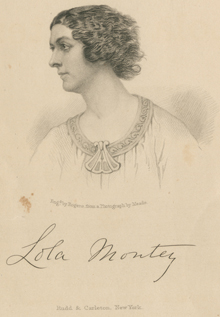Making Her Own Path: Lola Montez
Lola Montez, a courtesan, dancer, actress, and lecturer, wielded considerable political influence in Europe and was an often-referenced example of a woman who stepped beyond the bounds of proper behavior. After the failure of a runaway marriage, she trained as a dancer and traveled the royal courts of Europe, mingling with monarchs and intellectuals, where her forceful, captivating personality won her both friends and enemies. In Bavaria, where she was the mistress of King Ludwig I, she helped convince the king to advocate for popular rights, an unpopular move that was worsened by the nobility’s disdain for a king who let himself be swayed by a woman’s advice. Fleeing death threats in Bavaria, she moved to America, where she performed as a dancer, actress, and lecturer. In one of her public lectures, she proclaimed:
It takes most women two-thirds of their lifetime to discover, that men may be amused by, without respecting them; and every woman may make up her mind that to be really respected, she must possess merit, she must have accomplishments of mind and heart, and there can be no real beauty without these. (Lectures of Lola Montez, p.121-122)
The price of Lola’s willfulness and independence was abundant negative press that often verged on slander; as an 1857 pamphlet by James Glenn entitled Venereal Disease articulated, “Lola is such an infamous character, and so notorious, that she does not deserve any delicate treatment.” Lola’s dismissal of feminine delicacy was an affront to the ideal of a meek, mild, and submissive woman. A friend wrote of her:
The great misfortune was that there was too much of her to be held within the prescribed and safe limits allotted to woman; but there was not enough to enable her to stand securely beyond the shelter of conventional rules…Such is the social and moral fabric of the world, that woman must be content with an exceedingly narrow sphere of action, or she must take the worst consequences of daring to be an innovator and a heretic.” (Lectures of Lola Montez, p. 14-15).
In summary, the appearance of these controversial women in the public eye – and the great popularity of their published narratives – was a sign that American society was grappling with significant changes, such as industrialization and urbanization. While the advent of these changes meant addressing new social ills, like growing prostitution, it also meant that women were able to challenge their narrowly prescribed roles, charting new paths through conceptions of virtue and propriety.
